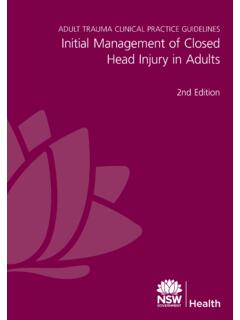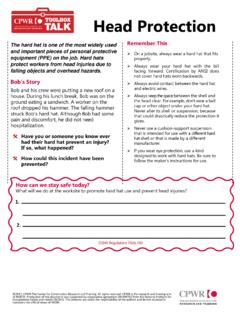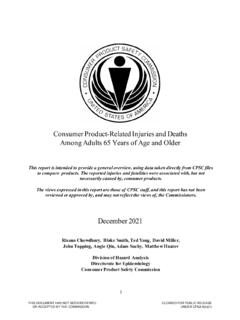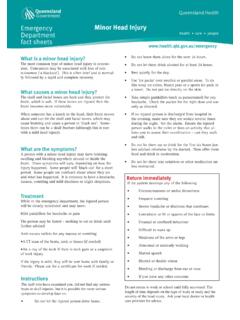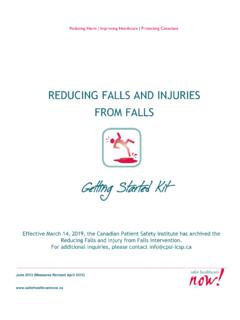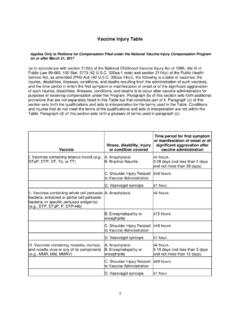Transcription of Traumatic Brain Injury - Centers for Disease Control and ...
1 Brain InjuryIN THE UNITED STATESE mergency Department Visits,Hospitalizations and Deaths 2002 Department of Health and Human ServicesCenters for Disease Control and PreventionTraumatic Brain InjuryIN THE UNITED STATESE mergency Department Visits, Hospitalizations and Deaths 2002 DEPARTMENT OF HEALTH AND HUMAN SERVICESC enters for Disease Control and PreventionNational Center for Injury Prevention and ZXYXA uthoRsMark Faul, PhD, MSNational Center for Injury Prevention and ControlDivision of Injury ResponseLikang Xu, MD, MSNational Center for Injury Prevention and ControlDivision of Injury ResponseMarlena M. Wald, MPH, MLSN ational Center for Injury Prevention and ControlDivision of Injury ResponseVictor G.
2 Coronado, MD, MPHN ational Center for Injury Prevention and ControlDivision of Injury ResponseACkNowleDgmeNtsThe authors would like to thank Vikas Kapil and Lisa McGuire for theireditorial comments, Karen Thomas for her programmingassistanceand Michael Lionbarger. The authors also offer sincere appreciationto the manyadvisors to this report, including Kevin Webb andDionneWilliams, for their Brain Injury in the United States: EmergencyDepartment Visits, Hospitalizations and Deaths 2002 2006is apublication of the National Center for Injury Prevention andControl, Centers for Disease Control and Prevention. The findings and conclusions in this report are those of theauthors and do not necessarily represent the official position of the Centers for Disease Control and Prevention (CDC).
3 SuggesteD CItAtIoN:Faul M, Xu L, Wald MM, Coronado Brain Injury in the United States: EmergencyDepartment Visits, Hospitalizations and Deaths 2002 (GA): Centers for Disease Control and Prevention,National Center for Injury Prevention and Control ; 2010. Centers for Disease Control and PreventionThomas R. Frieden, MD, MPH, DirectorNational Center for Injury Prevention and ControlRobin Ikeda, MD, MPA, Acting DirectorDivision of Injury ResponseRichard C. Hunt, MD, FACEP, Directorthe Power of Data2traumatic Brain Injury in the united statesThis body of work is a vital tool for those who devise the strategies for prevention andtreatment. However, a critical dimension will be lost if one sees it only as data, if onedoes not try to put even a fleeting face behind the numbers.
4 They represent people who if they survived have had their lives significantly affected. Through research, we arefinding better ways to prevent Injury and improve acute care. We who are injured mayexperience improvement both in function and the quality of our lives when we haveaccess to rehabilitation and support to develop and utilize our remaining strengths andabilities. With so many lives affected, we seek and have the potential for independence,to have the chance to move beyond our disabilities and give back to society. As a survivor, as a disabled physician, I applaud this publication as a step toward makingthat possible. CLAUDIAL. OSBORN, DO, FACOICOLLEGE OFOSTEOPATHICMEDICINE, MICHIGANSTATEUNIVERSITY Society is more likely to take action against the ravages of Traumatic Brain Injury if it understands how pernicious, pervasive, and huge the problem POWER OF DATAA Message from a TBI Survivor2table of Contents3traumatic Brain Injury in the united statesExecutive Summary5 Key Findings 7 Background8 Report Contents and Organization9 Overview11 Annual Number of TBIs13 TBI as a Proportion of All Injuries14 TBI by Age Group15 TBI by Sex16 TBI by External Cause17 Summary of Findings External TBI Causes21 Conclusion21 Appendix A.
5 Tables23 Total TBI-Related Emergency Department Visits, Hospitalizations, and Deaths25 TBI-Related Emergency Department Visits by Age Group and Disposition26 TABLE OF CONTENTSTBI-Related Emergency Department Visits by Age Group and Sex27 TBI-Related Emergency Department Visits by Age Group and Race28 TBI-Related Emergency Department Visits by Age Group and External Cause29 TBI-Related Emergency Department Visits by Age Group and Motor Vehicle Cause30 TBI-Related Emergency Department Visits by Age Group and Payment Source31 TBI-Related Hospitalizations by Age Group and Disposition32 TBI-Related Hospitalizations by Age Group and Sex33 TBI-Related Hospitalizations by Age Group and Race 34 TBI-Related Hospitalizations by Age Group and External Cause35 TBI-Related
6 Hospitalizations by Age Group and Motor Vehicle Cause36 TBI-Related Hospitalizations by Age Group and Payment Source37table of Contents4traumatic Brain Injury in the united statesAppendix A: Tables continuedTBI-Related Deaths by Age Group and Sex38 TBI-Related Deaths by Age Group and Race39 TBI-Related Deaths by Age Group and External Cause 40 TBI-Related Deaths by Age Group and Motor Vehicle Cause41 Annual Estimates of All TBI from 2002 2006 42 Annual Rate Estimates of Fall-Related TBI Among Children Aged 0 14 Years 43 Annual Rate Estimates of Fall-Related TBI Among Adults Aged 65 Years and Older43 Appendix B: Methods and Data Sources45 Data Sources49 Identification of TBI Cases51 External Cause of Injury55 Population Data57 Statistical Analysis59 Limitations61 Index of Tables and Figures63 References69executive summary5traumatic Brain Injury in the united statesTraumatic Brain Injury (TBI) is an important public health problemin the United States.
7 TBI is frequently referred to as the silentepidemic because the complications from TBI, such as changesaffecting thinking, sensation, language, or emotions, may not bereadily apparent. In addition, awareness about TBI among thegeneral public is the TBI Act of 1996 (Public Law 104 166), Congress firstcharged the Centers for Disease Control and Prevention (CDC) with determining the incidence and prevalence of Traumatic braininjury in all age groups in the general population of the UnitedStates. In response, CDC has produced, Traumatic Brain Injury inthe United States: Emergency Department Visits, Hospitalizationsand Deaths 2002 data on TBI are critical to understanding theimpact of TBI on the American people.
8 This report presents data onTBI-related emergency department visits, hospitalizations, anddeaths for the years 2002 through 2006 and can be used todetermine the number of TBIs occurring each year, groups mostaffected, and the leading causes of TBI. This important informationcan be used to document the need for TBI prevention, to identifyresearch and education priorities, and to support the need forservices among individuals living with a report is an update to CDC s previously published reportreleased in 2004 and is intended as a reference for policymakers,health care and service providers, educators, researchers,advocates, and others interested in knowing more about theimpact of TBI in the United SUMMARY6traumatic Brain Injury in the united stateskey Findings7traumatic Brain Injury in the united statesTBI in the United States An estimated million people sustain a TBI annually.
9 Of them: 52,000 die, 275,000 are hospitalized, and million, nearly 80%, are treated and released from anemergency department. TBI is a contributing factor to a third ( ) of all Injury -related deaths in the United by Age Children aged 0 to 4 years, older adolescents aged 15 to 19years, and adults aged 65 years and older are most likely to sustain a TBI. Almost half a million (473,947) emergency department visits forTBI are made annually by children aged 0 to 14 years. Adults aged 75 years and older have the highest rates of TBI-related hospitalization and by Sex In every age group, TBI rates are higher for males than for females. Males aged 0 to 4 years have the highest rates for TBI-related emergency department visits, hospitalizations, and deaths combined.
10 TBI by External Cause Falls are the leading cause of TBI. Rates are highest for childrenaged 0 to 4 years and for adults aged 75 years and older. Falls result in the greatest number of TBI-related emergency department visits (523,043) and hospitalizations (62,334). Motor vehicle traffic Injury is the leading cause of TBI-relateddeath. Rates are highest for adults aged 20 to 24 years. Additional TBI Findings* There was an increase in TBI-related emergency department visits ( ) and hospitalizations ( ) from 2002 to 2006. There was a 62% increase in fall-related TBI seen in emergencydepartments among children aged 14 years and younger from2002 to 2006. There was an increase in fall-related TBIs among adults aged 65and older; 46% increase in emergency department visits, 34% increase in hospitalizations, and 27% increase in TBI-related deaths from 2002 to 2006.










